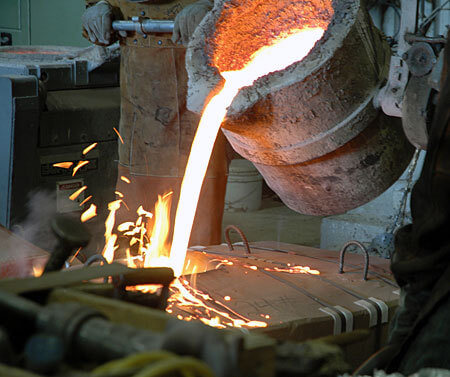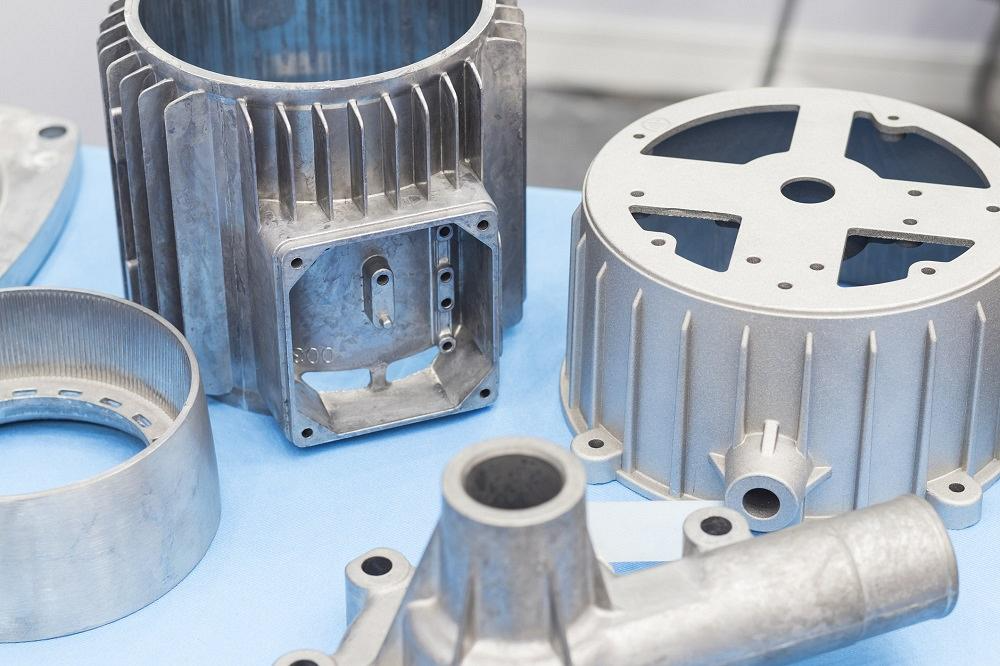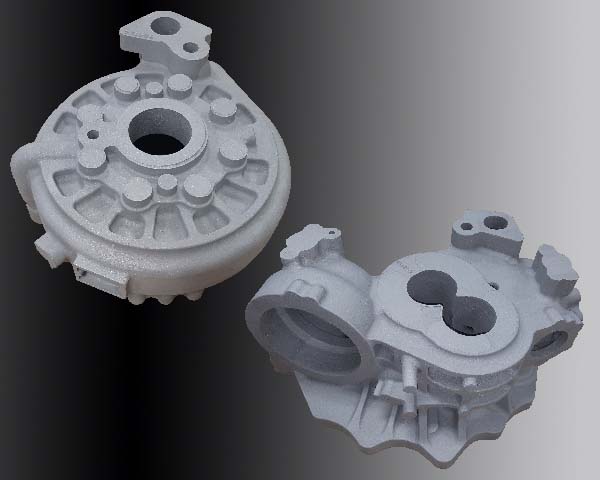The importance of aluminum casting in creating lightweight metal parts
Wiki Article
Understanding the Ecological Benefits of Light Weight Aluminum Shop Techniques
Light weight aluminum factory methods play an essential role ahead of time sustainability within the manufacturing field. By executing innovative reusing techniques and energy-efficient methods, these methods substantially minimize waste and carbon impacts. Ingenious spreading approaches further improve source preservation initiatives. As markets significantly focus on ecological duty, comprehending the complete impact of these practices becomes essential. What certain improvements are leading the way in this transformation?The Role of Light Weight Aluminum in Lasting Manufacturing
Lots of materials contribute to sustainable production, aluminum stands out due to its special buildings and recyclability. This lightweight steel is not just long lasting however also possesses exceptional deterioration resistance, making it an ideal option for various applications, from automotive to construction. Its high strength-to-weight proportion causes energy cost savings throughout transport and usage. Additionally, light weight aluminum can be recycled forever without losing its fundamental high qualities, promoting a round economic climate.The production process of aluminum has actually evolved, incorporating energy-efficient methods that decrease carbon impacts. By making use of renewable resource resources, makers are increasingly reducing the ecological effect connected with light weight aluminum production. Furthermore, making use of recycled light weight aluminum calls for significantly much less power compared to drawing out and improving main aluminum, resulting in reduced greenhouse gas emissions. As industries seek sustainable solutions, light weight aluminum's flexibility and eco-friendly characteristics placement it as a critical material in the pursuit of greener manufacturing practices.
Advanced Recycling Techniques in Aluminum Foundries
Advanced recycling strategies in aluminum factories are revolutionizing the means scrap aluminum is refined and recycled. Ingenious methods, such as closed-loop recycling systems, enable foundries to reclaim light weight aluminum from production waste and outdated products effectively. These systems decrease worldly loss and boost the high quality of recycled light weight aluminum, making it a feasible option to primary light weight aluminum production.Furthermore, advanced sorting innovations, including automated optical sorting and X-ray fluorescence, boost the separation of light weight aluminum from other materials, making certain higher pureness levels in recycled outcomes. This precision decreases contamination, which can compromise the honesty of the end product.
The integration of innovative melting modern technologies, such as induction melting and energy-efficient heaters, enhances the recycling process, decreasing energy usage. Collectively, these developments add to an extra lasting light weight aluminum market by lowering dependence on virgin materials and reducing greenhouse gas discharges linked with aluminum production.
Energy Effectiveness Improvements in Shop Operations
Power efficiency improvements in aluminum foundry operations can significantly boost sustainability methods. Executing waste warm recovery systems permits foundries to repurpose excess power, reducing total power consumption. Additionally, improvements in procedure automation enhance procedures, resulting in lowered waste and optimized resource usage.Waste Warm Recovery
Applying waste heat recovery systems in light weight aluminum foundries greatly boosts power effectiveness by recording and reusing excess thermal energy generated throughout production procedures. These systems facilitate the conversion of lost warm right into usable energy, which can be used for numerous applications within the factory, such as preheating materials or powering devices. By recuperating warm that would or else be gotten rid of right into the environment, shops can significantly lower their total energy consumption and greenhouse gas exhausts. This approach not only reduces operational expenses yet likewise promotes sustainable methods within the sector. Furthermore, the fostering of waste warmth recuperation innovations lines up with governing requirements aimed at decreasing environmental impact, making it a crucial component of modern aluminum factory procedures.Refine Automation Perks
Automating processes in light weight aluminum shops can considerably improve power efficiency by enhancing production operations and reducing waste. By implementing sophisticated modern technologies such as robotics and artificial intelligence, foundries can simplify operations, lessening unnecessary energy consumption. Automated systems facilitate accurate control over temperature and product handling, ensuring that power is used only when required. Furthermore, real-time monitoring permits instant changes, decreasing the risk of power loss. The combination of automation not just boosts productivity yet likewise reduces operational prices, making shops more competitive. Because of this, these energy-efficient practices add considerably to sustainability objectives, reducing the environmental impact of aluminum manufacturing while fulfilling raising market needs - Aluminum Casting Company. Enhanced power effectiveness via automation stands for an important step in the direction of greener shop operationsDecreasing Waste With Cutting-edge Casting Methods
Ingenious casting approaches play a vital duty in reducing waste in light weight aluminum foundries. Methods such as sophisticated molding and the usage of recyclable materials considerably decrease manufacturing scrap. These practices not just improve effectiveness however also add to a more lasting manufacturing process.Advanced Molding Techniques
As markets progressively focus on sustainability, progressed molding strategies in light weight aluminum foundries become efficient solutions for lowering waste. These innovative techniques, such as 3D printing and accuracy mold and mildew production, significantly improve the effectiveness of the casting process. By utilizing computer-aided design (CAD) and simulation technologies, producers can enhance mold geometry, decreasing material usage while preserving product stability. Additionally, advanced methods enable the manufacturing of intricate forms that traditional methods can not accomplish, decreasing the need for extra machining and thus reducing scrap material. The flexibility of these methods permits rapid prototyping, more lowering lead times and power intake. Overall, the execution of advanced molding techniques represents an important action towards ecologically liable aluminum production, aligning with worldwide sustainability objectives.Recyclable Material Use
Recyclable products play a critical function in minimizing waste within light weight aluminum factories, changing the spreading landscape via their reliable use. By integrating scrap light weight aluminum and other recyclable parts right into the production process, shops can significantly decrease the demand for virgin products. This not only preserves natural deposits but likewise minimizes power consumption connected with mining and refining. Innovative spreading techniques, such as die casting and sand casting, enable smooth integration of these products, making certain top quality outcomes. The use of recyclable products fosters a round economic situation, where resources are constantly reused and repurposed, reducing land fill payments. Eventually, the strategic usage of recyclables enhances sustainability while promoting cost-effectiveness in light weight aluminum factory operations.Lessening Production Scrap

Life Process Assessment of Aluminum Products
Aluminum is widely acknowledged for its sturdy and lightweight residential properties, a complete Life Cycle Evaluation (LCA) reveals the environmental effects connected with its usage, disposal, and production. The LCA process analyzes the power intake, greenhouse gas discharges, and resource depletion linked to aluminum items from removal of bauxite ore to end-of-life management. Key aluminum production is energy-intensive, typically counting on nonrenewable fuel sources, which adds substantially to carbon footprints. In comparison, reusing aluminum supplies considerable ecological benefits, as it utilizes only a fraction of the power required for primary manufacturing. The reusing process minimizes land fill waste and saves natural resources. The LCA also considers the product's longevity and possibility for reuse, highlighting the significance of lasting design. Generally, understanding the life cycle impacts of aluminum products is essential for making educated choices that prioritize ecological sustainability within the sector.Instance Studies: Effective Lasting Practices in the Sector
The light weight aluminum sector has actually begun to embrace innovative sustainable practices that address the environmental challenges identified in Life Cycle Assessments. One noteworthy situation is a leading factory that carried out a closed-loop recycling system, substantially reducing waste and power consumption. By reusing scrap aluminum in production, the center attained a 40% decrease in its carbon footprint.Another instance entails a manufacturer that embraced sustainable energy resources, powering its more info operations with solar and wind energy - aluminum casting. This change not only reduced greenhouse gas discharges yet likewise enhanced the firm's online reputation amongst ecologically conscious customers
Furthermore, a third shop has actually invested in advanced spreading methods, which enhance material use and minimize defects, better lowering source consumption. These study show that the aluminum market is capable of integrating sustainable practices, demonstrating both environmental responsibility and financial practicality, inevitably contributing to a more lasting future.
Often Asked Inquiries
Just How Does Aluminum Compare to Various Other Steels in Sustainability?
Aluminum is generally taken into consideration much more lasting than many steels because of its recyclability, lower energy needs for production, and decreased environmental effect. Its lifecycle effectiveness exceeds that of steel and copper in numerous applications.What Is the Carbon Footprint of Light Weight Aluminum Factory Processes?
The carbon footprint of light weight aluminum factory procedures differs, commonly varying from 4 to 15 statistics lots of CO2 per bunch of light weight aluminum created. Aspects influencing this consist of energy sources, modern technology, and the effectiveness of procedures.Exist Health Risks Connected With Aluminum Factory Workflow?

What Are the Expenses Associated With Sustainable Aluminum Techniques?
The prices related to lasting light weight aluminum strategies consist of higher first financial investments in technology, possible increases in operational expenditures, and continuous upkeep. These are usually countered by long-term savings and reduced environmental impact.
How Does Light Weight Aluminum Recycling Impact Resident Communities?
Light weight aluminum recycling favorably impacts regional communities by producing jobs, lowering garbage dump waste, and reducing power prices. It cultivates economic growth and advertises environmental stewardship, leading to healthier living problems and boosted community involvement in sustainability initiatives.Furthermore, the usage of recycled aluminum requires significantly much less energy contrasted to removing and refining primary aluminum, leading to reduced greenhouse gas exhausts. Advanced reusing strategies in aluminum foundries are reinventing the means scrap light weight aluminum is processed and reused. Precision aluminum casting. Carrying out waste warmth recovery systems in aluminum shops significantly improves power effectiveness by capturing and recycling excess thermal power generated during manufacturing procedures. Automating procedures in aluminum foundries can greatly enhance energy effectiveness by maximizing manufacturing operations and minimizing waste. The carbon impact of light weight aluminum shop procedures differs, typically ranging from 4 to 15 metric heaps of Carbon dioxide per lot of light weight aluminum created
Report this wiki page